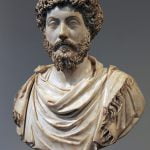The Antonine Plague (pestis Antonini), also called the Plague of Galen, was a pandemic brought to the Roman Empire by returning Roman soldiers from the Middle East campaign. The scourge, which according to today’s research was most likely smallpox or measles, overrun the Empire in 165-180 CE.
According to preserved historiographic sources, Rome suffered the most from diseases in the first centuries of the Republic, especially in the second half of the fifth century and the beginning of the fourth century BCE. According to Titus Livy in Ab urbe condita epidemics appeared on average every 8 years (between 490-292 BCE) and later every 4 to 8 years. (between 212 and 165 BCE). In later years, epidemics were rarer, which does not mean that there were fewer of them, but they simply do not mention the source.
One of the plagues that have been well described by ancient writers is the Antonine plague. Modern researchers have a large amount of historical data related to this issue, which, however, is sometimes quite fragmentary. The most important source is the notes of Galen – a physician of Lucius Verus and Marcus Aurelius – who was an eyewitness to the spread of the plague. Later writers also left many details about the scourge, including Cassius Dion, Ammianus Marcellinus, Eutopius, Orozjus and others. Also, inscriptions or coins from the 2nd century CE give us a great view of what social and economic changes took place during and after the end of the plague.
As a result of the plague, Emperor Lucius Verus in 169 CE, co-coordinator of Marcus Aurelius, most likely died. The epidemic returned nine years later and, according to Roman historian Cassius Dion, killed 2,000 Romans a day – a quarter of those infected. The total number of victims of the plague was expected to be up to 5 million, which means that sometimes one-third of the population in the regions concerned died, and the Roman army was significantly depleted. Some researchers say that between 14 and 20% of the population of the Roman Empire died from the plague. Such losses could not be rebuilt for the next century, which was indirectly introduced by Rome in the so-called “great crisis of the third century”.
The appearance of the plague is associated with the campaign in the east, where another war with the Parthians has already begun. To regain Roman control over Armenia, he was sent to the region in 162 CE by Lucius Verus. After four years, he finally managed to force the Parthians to make concessions and regain Armenia, but his legions were in Mesopotamia, where the plague appeared. Roman sources say that the epidemic first appeared during the Roman siege of Seleution over the Tiger in the winter of 165-166 CE. Soldiers began to fall ill and the army retreated, carrying disease into the Empire. In 165 CE the first inhabitants of Smyrna began to die, and a year later the plague entered Rome.
In 166 CE, when Rome was overcome by epidemics, the Greek physician and writer Galen left the capital and went to Asia Minor. This fact is negatively assessed by modern researchers, according to whom the doctor simply chickened. He returned to Rome in 168 CE – at the call of the co-officers of Verus and Aurelius. He was present at the time of the outbreak of the “great plague” (as he described it) among soldiers stationed in Aquileia in the winter of 168/9 CE. Galen described all signs of the epidemic in detail in his treatise Methodus Medendi and other side writings. He presented the plague as “great” and long-lasting. He gave symptoms of fever, diarrhoea, pharyngitis, dry skin and sometimes pustules on the ninth day of illness.
Medics of antiquity did not define new diseases but rather defined them as disease, plague, plague or poisonous disease (pestis, pestilentia or lues). Today it is difficult to clearly determine what disease decimated the Empire, but specialists say it could be smallpox or measles. The ancients did not isolate the infected without realizing the infectious nature of the plagues. Hence the huge number of victims in urban areas, especially in hot months such as August or September. Ammianus Marcellinus claims that the plague spread very quickly throughout the Empire, reaching Gaul and the legions on the Rhine. In 167 CE the plague was already in Dacia or Egypt. The late Roman historian Eutropius wrote that in the whole Empire, as a result of the plague, a huge number of people died.
The plague caused a significant demographic decline. People died by thousands, there was hunger in Italy, and in Egypt, some of the fields were not sown. In 168/9 CE, there was an exceptional reduction in the inflow of taxes in Egypt, and in 168 CE, recruitment to the army in the Egyptian province was very slow. A devastated society and army caused Rome to lose its efficiency and be more susceptible to attacks by neighbouring peoples and countries.
Panic and terror caused many people to seek help in magic. Many saw God’s punishment at the same time. Victims were made and guilty parties were sought. The scapegoat was Christians, seen as a sect that did not recognize Roman deities and the divinity of the emperor himself. There was great persecution: it was then that the so-called martyrs from Lyon and Justin.
A similar plague appeared once again in the Roman Empire, namely in 250 CE – and was called the Plague of Cyprian.








